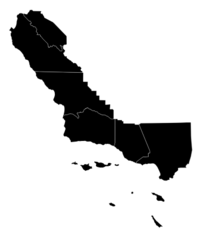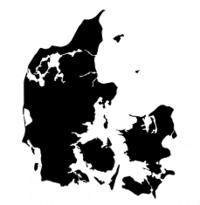California Three States Initiative (2018)/California
Welcome to the (New) State of California Counties: Los Angeles • Monterey • San Benito • San Luis Obispo • Santa Barbara • Ventura Learn more about the California Three States Initiative (2018)
Learn more about the proposed states of (New) California, Northern California, and Southern California
|
The California Three States Initiative was designed to divide the state of California into three new states California, Northern California, and Southern California.[1]
The ballot initiative cannot order the federal government to partition California into three states. Section 3 of Article IV of the U.S. Constitution requires the consent of the California State Legislature and the U.S. Congress to divide California. The initiative itself states that the initiative fulfills the role of the legislature, a provision that could be challenged in court, according to law professor Vikram David Amar.[1][2]
Tim Draper, a venture capitalist and cryptocurrency investor, proposed the ballot initiative.[3] Draper first proposed breaking the state into multiple states in 2013. He called his first plan Six Californias, which, as the name suggests, would have divided the state into six states.
This page provides information about the California Three States Initiative's proposed state of California.
What counties would be included in the new state of California?
The new state of California would be composed of the following six counties:[1]
What would be the size of the state?
The new state of California would be 16,659 square miles, making the proposed state the 42nd largest, excluding the new states of Nothern California and Southern California. Including the new states of Nothern California and Southern California, the new state of California would be the 44th largest state. The new state of California would be smaller than West Virginia but larger than Maryland. The new state of California would be about the size of the nation of Denmark.[4]
| State of California | Nation of Denmark |
|---|---|
 |
 |
What would be the state's population?
The new state of California would have an estimated population of 12.25 million (as of 2017) and a population growth rate of 3.74 percent (between 2010–2017). With 12.25 million people, the new state of California would have the 7th largest population in the United States, excluding the new states of Northern California and Southern California. Including Northern California and Southern California, the new state of California would have the 9th largest population in the U.S. The state would have a population larger than Ohio but smaller than Pennsylvania by about a half million people.[5]
What would be the state's largest cities?
Los Angeles would be the largest city in the new state of California. With a population of nearly 4 million (as of 2017), about one-third of the state's population would live in Los Angeles. The 10 largest cities in the new state of California would be as follows:[5]
| Largest cities in the new state of California | ||
|---|---|---|
| City | Population (2017) | Mayor (2018) |
| Los Angeles | 3,999,759 | Eric Garcetti (D) |
| Long Beach | 469,450 | Robert Garcia (D) |
| Santa Clarita | 210,888 | Laurene Weste (N/A) |
| Oxnard | 210,037 | Tim Flynn (N/A) |
| Glendale | 203,054 | Paula Devine (D) |
| Lancaster | 160,316 | R. Rex Parris (R) |
| Salinas | 157,596 | Joe Gunter (R) |
| Palmdale | 157,519 | Jim Ledford (R) |
| Pomona | 152,939 | Tim Sandoval (N/A) |
| Torrance | 146,758 | Patrick J. Furey (D) |
What would the politics of the state look like?
The proposed state of California would be considered a safe Democratic state in most statewide elections, based on current voting trends.
In the proposed state of California, 49.68 percent of registered voters were Democrats, 19.69 percent were Republicans, and 30.64 percent were independents or members of other parties (as of May 21, 2018).
| Voter registration in the three states of California | |||
|---|---|---|---|
| Data | (New) California | Northern California | Southern California |
| Voter Registration (May 2018)[6] | 81.68% | 75.02% | 71.31% |
| Democrats (May 2018)[6] | 49.68% | 46.78% | 36.55% |
| Republicans (May 2018)[6] | 19.69% | 22.48% | 33.16% |
| Independents/Others (May 2018)[6] | 30.64% | 30.74% | 30.29% |
In 2016, Democrat Hillary Clinton defeated Republican Donald Trump for president in California, receiving the state's 55 electoral votes. Trump won the presidential election nationwide. Clinton received 61.73 percent of the vote in California, while Trump received 31.62 percent. If California was divided into the three states proposed by the Three States Initiative in 2016, Clinton would have won all three of the states. In California, which would include Los Angeles, Clinton would have received 69.00 percent to Trump's 24.86 percent.
In 2012, incumbent President Barack Obama defeated Republican Mitt Romney in California and nationwide. President Obama received 60.34 percent of the vote in the existing state of California, and Mitt Romney received 37.18 percent of the vote. Under the proposal to divide California into three states, President Obama would have won each of the three states. Obama would have received 66.95 percent of the vote in the new state of California.
| Presidential elections in the three states of California, 1976-2016 | |||||||||
|---|---|---|---|---|---|---|---|---|---|
| Candidates | (New) California | Northern California | Southern California | ||||||
| Election | Democrat | Republican | Democrat | Republican | Democrat | Republican | Democrat | Republican | |
| 2016 | Clinton | Trump | 69.00% | 24.86% | 64.91% | 27.94% | 51.57% | 41.86% | |
| 2012 | Obama | Romney | 66.95% | 30.53% | 65.03% | 32.69% | 49.13% | 48.50% | |
| 2008 | Obama | McCain | 67.01% | 30.99% | 65.56% | 32.35% | 50.11% | 47.89% | |
| 2004 | Kerry | Bush | 59.51% | 37.35% | 59.26% | 38.21% | 41.20% | 48.80% | |
| 2000 | Gore | Bush | 60.38% | 35.17% | 56.25% | 37.78% | 43.23% | 52.72% | |
| 1996 | Clinton | Dole | 56.56% | 33.32% | 54.32% | 34.29% | 41.76% | 47.85% | |
| 1992 | Clinton | Bush | 52.54% | 29.04% | 50.63% | 28.99% | 36.13% | 39.60% | |
| 1988 | Dukakis | Bush | 50.11% | 48.65% | 53.59% | 44.88% | 37.14% | 61.58% | |
| 1984 | Mondale | Reagan | 42.66% | 56.19% | 47.26% | 51.39% | 31.81% | 67.07% | |
| 1980 | Carter | Reagan | 38.62% | 51.28% | 39.19% | 46.92% | 28.42% | 61.94% | |
| 1976 | Carter | Ford | 49.05% | 48.36% | 50.15% | 45.84% | 42.00% | 55.52% | |
| Sources: Dave Leip's Atlas of U.S. Presidential Elections and California Secretary of State | |||||||||
What would the state's socioeconomic indicators look like?
Using the U.S. Census Bureau's data on socioeconomic variables for California's counties, the new state of California would have a per capita income of $29,660, a mean household income of $86,915, a poverty rate of 17.54 percent, and an unemployment rate of 5.52 percent.[5]
| Socioeconomics in the three states of California | |||
|---|---|---|---|
| Data | California | Northern California | Southern California |
| Education: Bachelor's Degree (2016)[5] | 30.72% | 37.15% | 27.97% |
| Income: Mean Household (2016)[5] | $86,915 | $101,202 | $83,438 |
| Income: Per Capita (2016)[5] | $29,660 | $37,067 | $27,732 |
| Unemployment Rate (2016)[5] | 5.52% | 5.27% | 5.73% |
| Poverty Rate (2016)[5] | 17.54% | 13.37% | 17.14% |
What would the new state's demographics look like?
Using data from 2016, the population of the new state of California would be 47.51 percent Hispanic/Latino. Whites would be the largest racial group at 56.72 percent, including individuals who identified as white (race) and Hispanic/Latino (ethnicity).[5]
| Sex, race, and ethnicity in the three states of California | |||
|---|---|---|---|
| Data | California | Northern California | Southern California |
| Sex: Male (2016)[5] | 49.42% | 49.60% | 49.97% |
| Sex: Female (2016)[5] | 50.58% | 50.40% | 50.03% |
| Race: White (2016)[5] | 56.72% | 60.15% | 66.36% |
| Race: Black (2016)[5] | 7.21% | 5.60% | 4.88% |
| Race: American Indian/Alaska Native (2016)[5] | 0.65% | 0.77% | 0.79% |
| Race: Asian (2016)[5] | 12.82% | 18.38% | 10.48% |
| Race: Hawaiian/Pacific Islander (2016)[5] | 0.26% | 0.59% | 0.32% |
| Ethnicity: Hispanic/Latino (2016)[5] | 47.51% | 24.97% | 43.31% |
What current state universities would be located in the new state?
The current state of California has two public college systems—the University of California (UC) and California State University (CSU). The new state of California would inherit the infrastructure of two of 10 (20 percent) of the University of California schools, including UC-Los Angeles, and seven of 23 (30 percent) of the California State University schools.[7][8]
| California state universities in the three states of California | |||
|---|---|---|---|
| System | California | Northern California | Southern California |
| University of California | •UC Los Angeles •UC Santa Barbara |
•UC Berkeley •UC Davis •UC Merced •UC San Francisco •UC Santa Cruz |
•UC Irvine •UC Riverside •UC San Diego |
| California State University | •California State Polytechnic University, Pomona •CSU, Channel Islands •CSU, Dominguez Hills •CSU, Long Beach •CSU, Los Angeles •CSU, Monterey Bay •CSU, Northridge |
•California Polytechnic State University, San Luis Obispo •CSU Maritime Academy •CSU, Chico •CSU, East Bay •CSU, Stanislaus •Humboldt State University •Sacramento State University •San Francisco State University •San Jose State University •Sonoma State University |
•CSU, Bakersfield •CSU, Fresno •CSU, Fullerton •CSU, San Bernardino •CSU, San Marcos •San Diego State University |
See also
Footnotes
- ↑ 1.0 1.1 1.2 California Attorney General, "Initiative 17-0018," accessed August 21, 2017
- ↑ Justia, "What California Voters Should Focus on When Voting on Tim Draper’s “CAL 3” Initiative," April 19, 2018
- ↑ Bloomberg, "This Cryptocurrency Billionaire Is Trying to Split California Into Three States," May 10, 2018
- ↑ National Association of Counties, "About Counties," accessed May 2, 2018
- ↑ 5.00 5.01 5.02 5.03 5.04 5.05 5.06 5.07 5.08 5.09 5.10 5.11 5.12 5.13 5.14 5.15 5.16 U.S. Census Bureau, "Fact Finder, accessed May 2, 2018
- ↑ 6.0 6.1 6.2 6.3 Cite error: Invalid
<ref>tag; no text was provided for refs namedvrf - ↑ University of California, "UC-System," accessed June 12, 2018
- ↑ California State University, "Campuses," accessed June 12, 2018
 |
State of California Sacramento (capital) |
|---|---|
| Elections |
What's on my ballot? | Elections in 2025 | How to vote | How to run for office | Ballot measures |
| Government |
Who represents me? | U.S. President | U.S. Congress | Federal courts | State executives | State legislature | State and local courts | Counties | Cities | School districts | Public policy |





